Table of Contents
In 2014, a unique commemorative coin was released to mark the 50th anniversary of the Kennedy Half-Dollar. This coin is not just a collector’s item but a tribute to one of America’s most memorable presidents, John F. Kennedy. The John F. Kennedy Gold Coin stands out not only for its material and design but also for its historical significance and collectible value. Here, we delve deep into the details and the allure that makes this coin a coveted piece among collectors.
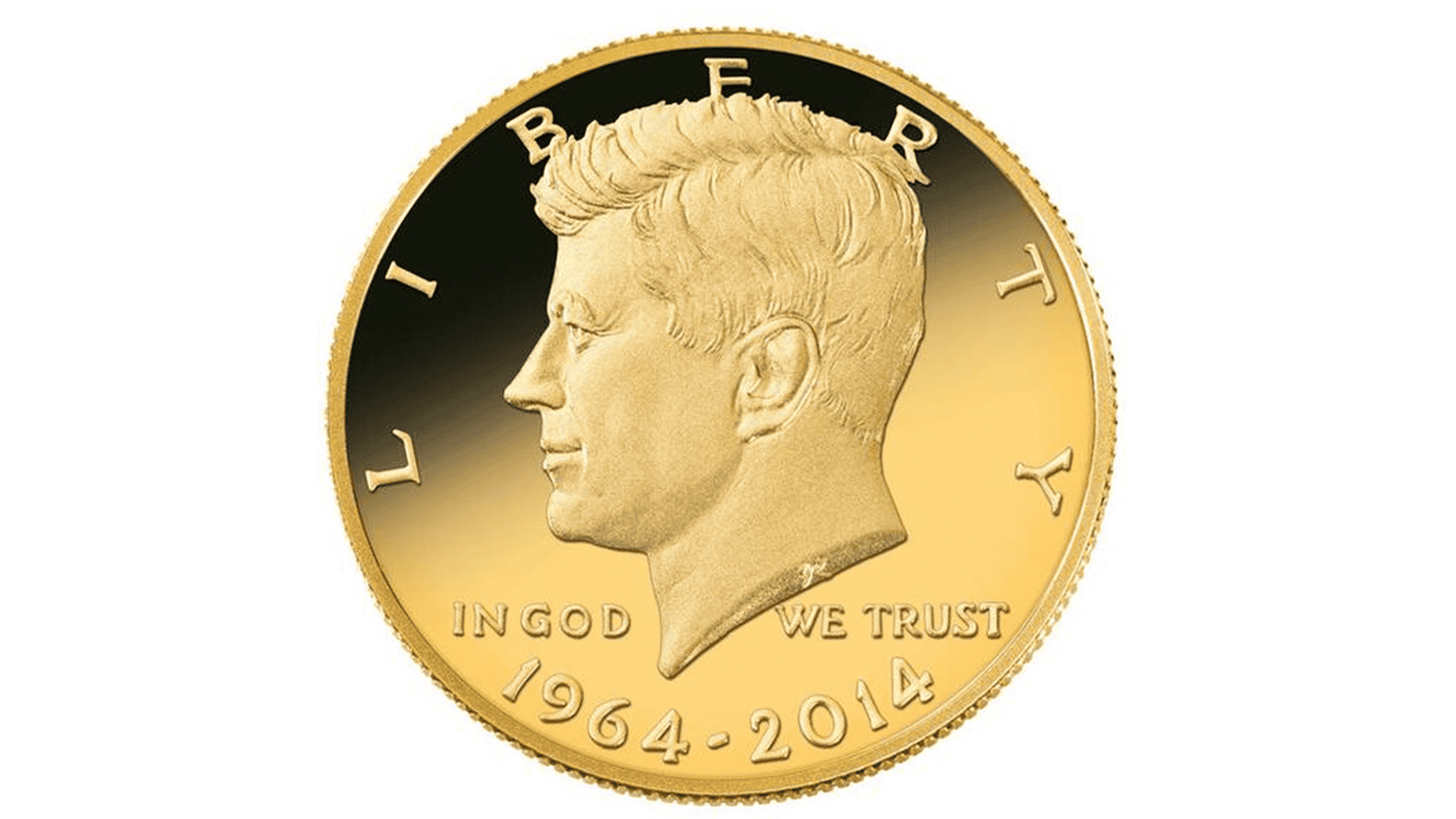
The Kennedy Half-Dollar Collection with Platinum and Gold Highlights is a collectible of beauty, significance, and value. The Philadelphia and Denver Mintages of this JFK Kennedy Half Dollar U.S. 2-Coin Set are 24KT gold-plated. The Merrick Mint highlights the original design of each piece by utilizing a unique, genuine process that involves 24KT gold plating.
The end product is an industry-leading, eternal 24KT gold-plated coin collector of the highest quality. On the obverse of each coin is a design of John F. Kennedy’s left picture, while on the reverse is a modified version of the presidential seal. Each coin is authentic U.S. legal cash, comes with a Full-Colorr 2-sided Authenticity Certificate, and is packaged in an acrylic container.
GET GOLD IRA GUIDE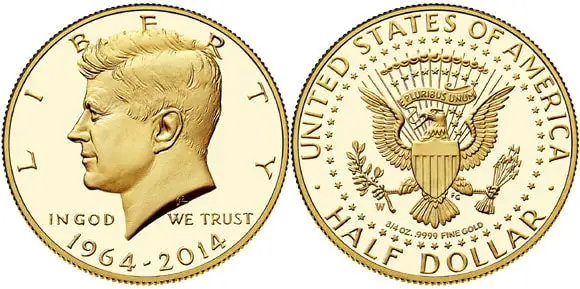
What is 24kt Gold Kennedy Half Dollar Value?
In 2024, the 24kt Gold Kennedy Half Dollar Value is around $2500 because the coin is struck in 3/4 of a troy ounce of 24 karats (99.99% pure) gold with a proof finish and specially issued to mark the 50th anniversary of the series.
The coins have a diameter of 1.205 inches (30.61 mm) and a thickness of 0.085 inches (2.16 mm), matching the specifications of a standard half-dollar.
The coins were priced at $1,240 each at the start of sales in 2014. However, today, we can find as low as $900 up to $1350 in the market. This coin’s worth is also related to the current gold price.
However, the price in 2024 is increased; see screenshot:
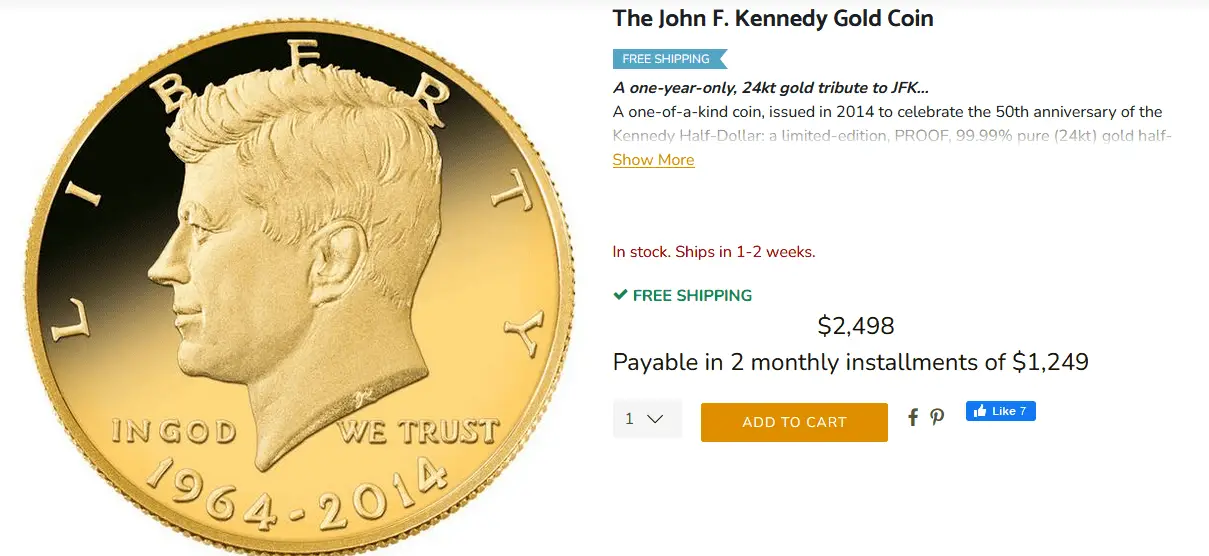
On November 22, 1963, just a few days after President John F.Kennedy’s deathd, the U.S. Treasury & U.S. Mint started planning to produce a coin in his honor. Mint engravers worked rapidly to produce a new design for the fifty-cent coin, which featured the President’s visage on the obverse (heads) side or the Presidential Seal just on the reverse (tails). On December 30, 1963, President Johnson approved a measure approving the design. Within a few weeks, minting started. Since Kennedy Half Dollar entered circulation more than 50 years ago, the coin has remained a collectible reminder of President Kennedy’s life and accomplishments.
Following President Kennedy’s funeral, the Mint, the Treasury, and the Kennedy family started talking about making a new coin in his honor. The half dollar, quarter, & nickel were a few considered coins. Nevertheless, Mrs. Jacqueline Kennedy thought the half dollar was the most suitable option because it wouldn’t call for the election of a new President. Eva Adams, Director of Mint, called engravers on November 27, 1963, to start creating a new half-dollar coin portraying President Kennedy. The half-dollar coin of the time portrayed Benjamin Franklin, a renowned philosopher, inventor, and revolutionary.
Congressional permission was necessary for each design modification within 25 years of the previous one. A measure to have Kennedy appear on the half-dollar was submitted by Texas Representative Henry Gonzalez (Democrat) at the beginning of December. On December 10, Lyndon Johnson, the newly elected President, approved the proposal for one Kennedy a half dollar and urged Congress to swiftly adopt the necessary legislation so that the striking of the new coin could start early in 1964.
President Johnson said that letters from several members of the general public had persuaded him to support the proposal. On December 30, 1963, It approved the legislation authorizing Kennedy half a dollar. Coinage dies were already in construction; utilizing the existing designs, the first dies could be finished on January 2, 1964. There were initially just proof coins produced. On January 30, 1964, the Denver Mint struck the first Kennedy half dollars designed for circulation, and the Philadelphia Mint struck them the following week. On February 11, 1964, authorities made ceremonial first strikes in Denver and Philadelphia.
Kennedy Half Dollar Design
Material and Quality
The John F. Kennedy Gold Coin is crafted from 99.99% pure gold, making it a 24-karat gold coin. It is noteworthy that the first U.S. half-dollar coin ever made from this precious metal sets it apart in aesthetic appeal and material value. The coin is presented in proof quality, which enhances its visual aspects, showcasing every detail crisply and clearly.
Unique Characteristics
This coin is the first of its kind in several respects:
- It is the first Gold U.S. half-dollar.
- It is the only U.S. coin struck with three-quarters of an ounce of Gold.
- It is the first U.S. gold coin specifically honoring John F. Kennedy.
These attributes ensure its uniqueness in the landscape of U.S. commemorative coins.
Having Gilroy Roberts, the Mint’s Chief Engraver between 1948 and 1964, on board for the design process helped guarantee that the new design would be ready for minting as soon as possible—approximately four weeks until January 1964, when they planned to begin striking a new Half Dollar. The obverse (heads) side features a redesigned profile sculpture by Roberts, while the reverse (tails) side features a revised Presidential Seal sculpture by Gasparro.
On December 13, the Philadelphia Mint made several experimental strikes of the new Kennedy Half Dollar. Roberts then took them to Washington, DC, to have them signed off on by Robert and Jacqueline Kenned, Director Adams, and Treasury Secretary C. Douglas Dillon. Although Mrs. Kennedy “thought it’d be an advantage if a part within hair became less apparent,” all agreed that the final style was successful. Roberts used the feedback to create a new coin version that eventually became a standard issue.
Commemorative Elements
The coin features the dual date “1964-2014,” signifying the 50-year span it commemorates. Additionally, it bears the “W” mint mark from the prestigious West Point Mint, indicating its high standard of minting and authenticity. The design mirrors the beloved Kennedy Half-Dollar, maintaining the traditional look while elevating it with Gold.
Except for minor adjustments made possible by evolving technology at the Mint, the design created by Roberts & Gasparro hasn’t altered much over the previous 50 years. The Mint has produced approximately 4.1 billion Kennedy Half Dollars since 1964, many of which have found their way into coin collections. Many coins with a 1964 date were melted down in the 1970s at a time of high silver prices to extract the silver. Between 1975 and 1976, authorities produced a unique design for the Kennedy Half Dollar to commemorate the United States Bicentennial. A dual date (1776–1966) was included on the redesigned coin’s obverse (heads) side, while Freedom Hall in Philadelphia was depicted on the reverse (tails) side.
Kennedy Half Dollar Coin Circulation
Just over 4 months after President Kennedy’s killing, on March 24, 1964, the Treasury released the first Kennedy Half Dollar coins to the general public. Customers lined up outside bank offices nationwide that morning to purchase the new currency. Banks intended to restrict sales to 40 coins per person because they expected high demand for the coin. Nevertheless, by midday, the 70,000 Kennedy Half Dollars that the Treasury had initially provided had been consumed by clients.
The first strike of 90 million 1964 Kennedy half dollars, about equal to the quantity of 1963 Franklin half dollars struck, had been authorized by Director Adams. As soon as the Mint became aware of the excessive demand for the new currency, it swiftly raised its goal to 140 million, or 160 million. However, Americans kept buying Kennedy Half Dollars as quickly as they could be produced. Congress granted the Mint special permission at the end of the year to keep minting 1964-dated coins throughout 1965, producing a total of 410 million.
By 1965, the government’s hoard of silver, which was in short supply globally due to the excessive Kennedy Half Dollar minting, had been significantly reduced. The Coinage Act of 1965, approved by Congress, authorized producing silver “clad” coins featuring copper cores. Kennedy Half Dollar coins’ silver content decreased from 90% to 40%, starting with 1965-dated pieces. The usage of silver was discontinued entirely in 1971, except for particular commemorative editions, as silver prices continued to rise.
In celebration of this beautiful coin, in 2014, made a particular coin that looks like this:
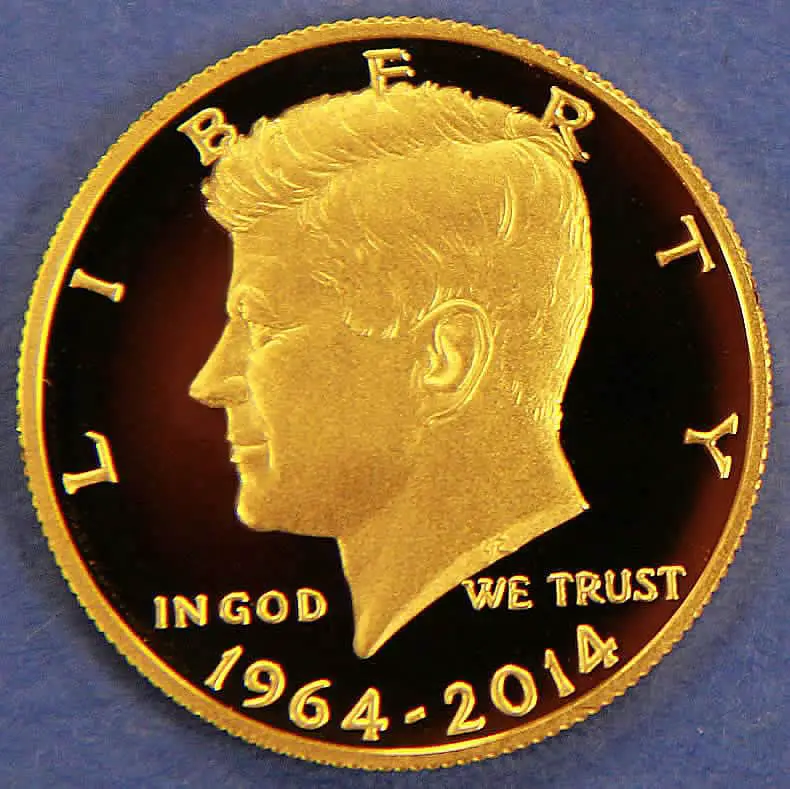
Conclusion
The Kennedy Half Dollar’s sustained popularity is evidence of the strength and tenacity of President Kennedy’s legacy and the coin’s timeless beauty. The Mint lowered the manufacturing of the currency in 2002 to levels that would fulfill collectors’ requests after realizing the Kennedy Half Dollar’s appeal, which was primarily a collectible item.
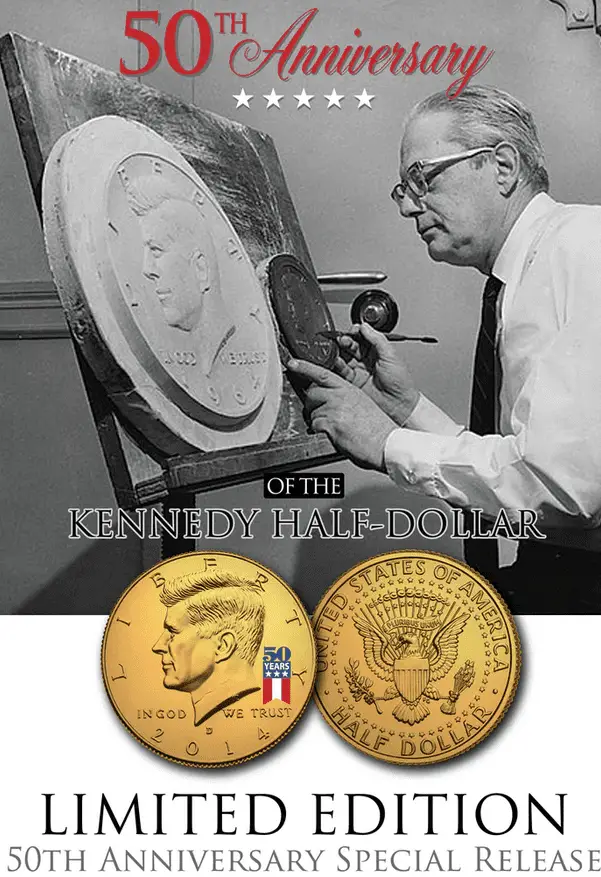
The coins are now exclusively offered to collectors through the Mint and are marked up from their fifty-cent face value. In 2014, the Mint unveiled a special edition proof coin of pure Gold and several additional versions to mark the Kennedy Half Dollar’s 50th anniversary. Like in 1964, the new gold coin’s demand immediately outstripped its supply, and after three days, the Mint stopped selling it at its retail locations.
The John F. Kennedy Gold Coin is more than just a monetary artifact; it is a piece of American history and a tribute to a beloved president. Its precious metal content, rare mintage, and historical significance make it a standout addition to any collection, embodying aesthetic beauty and a deep cultural reverence. This coin not only commemorates the past but also enriches the present, offering a tangible connection to the legacy of John F. Kennedy.
GET GOLD IRA GUIDE























